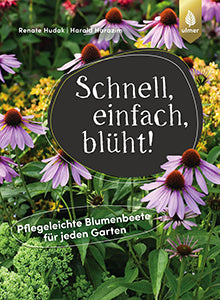Support and support perennials
Even though our goal is a bed with the lowest possible maintenance and a permanently self-regulating plant splendor, tall perennials in particular often need some support.

Support is needed
Many bedding perennials such as asters, but also tall wild perennials such as monkshood, appreciate being supported. This prevents them from falling apart or bending over in heavy rain, wind, and other bad weather. Even heavy, double peony blossoms look their best when supported and are not crushed to the ground under their own weight. This type of support often helps a plant develop its typical habit and thus the desired effect in the bed. Remember, even if you use the simplest option, a piece of shearing or binding wire: Do not constrict the plants too tightly and do not tie the shoots into bundles! This looks extremely unnatural, and in the wind the shoots usually bend right where they are tied. In addition, moisture and humidity remain for longer, which promotes fungal infections.
Use natural materials
In our garden, we prefer to use natural plant supports—that is, homemade supports or branches and binding material that can be found either in nature or in the garden, or at least blends in unobtrusively. Of course, such things don't last forever, but no problem: after a few years of gardening, the remains are simply composted, giving you another opportunity to be creative! Branches and twigs from hazel, willow, ornamental shrubs, or bamboo are ideal; sometimes particularly beautiful or unusual finds from a walk in the woods find a new purpose this way. Instead of string, you can also use the dead shoots of climbing plants, such as the native clematis (Clematis vitalba).
Well supported – reach high!
The simplest way is to tie individual shoots or entire plants with hemp or sisal twine to one or between two wooden stakes or strong branches stuck in the ground. Unfortunately, tying together loosely growing perennials, in particular, often results in the unsightly "bunches" described above. A better option is to use branched branches, which you place in the ground in the shape of an "X" in front of or around the perennials. The support structure should ideally be about two-thirds as tall as the plant will be when fully grown, so it doesn't overhang it. No matter what type of support you use, be sure to install it in the spring, when the perennials are still short. This allows the plants to slowly grow into the support structure and doesn't have to squeeze through it. Tall garden grasses such as Chinese silver grass, especially once they have reached a certain size after a few years, also tempt many gardeners to use string or rope to keep their lush growth in check. Unfortunately, this often completely distorts the typical appearance of these plants; their original intended structural function in the bed is not realized. If necessary, tie such grasses together as discreetly as possible. Division is often the better solution to curb their vigorous growth.
Bushy plants become compact thanks to pruning!
If plants grow compactly, tying and additional support are often unnecessary. Therefore, ensure a balanced and adequate supply of nutrients. "Pre-bloom pruning" (also known as pinching) helps you achieve bushy perennials without tying or supporting: Before the plants begin to flower, around mid-April/mid-May, trim the shoot tips by about 10–15 cm. The plants will then branch out more strongly and grow compactly and stockily. Suitable for example, tall asters, phlox, and hyacinth.
← vorheriger Post: Make your own compost – this is how waste becomes valuable humus

The content of this article is from the book:
Renate Hudak, Harald Harazim
Fast, easy, blooms– Easy-care flowerbeds for every garden
Price: EUR [D] 17.95 | EUR [A] 18.50 | CHF approx. 24.50
ISBN: 978-3-8186-0085-3
Publisher: Eugen Ulmer
What gardener doesn't want them: wonderfully blooming beds with harmonious color combinations that delight in every season, perfectly adapted to the respective location, and, of course, easy to maintain and create. In their book, the authors offer the best tips for beds that leave nothing to be desired: Based on your own garden situation, you can implement your personal favorite ideas from various sample beds.


























































































